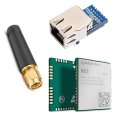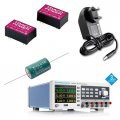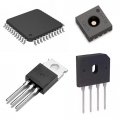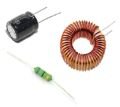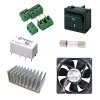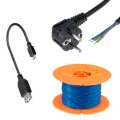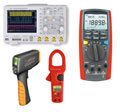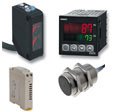

Although the LED is quite a simple component, at first sight, it is still good to consider several parameters to achieve long-term reliability in your application.
In particular, the design of industrial equipment requires careful consideration of all aspects.
1. SMD or THT?
In general, if the SMT version is acceptable in terms of LED visibility and its function in the device, then it is certainly easier and more convenient to use this type of LEDs, both because of a simple automated mounting and reflow soldering.
On the other hand, classic LEDs with wire leads (THT) still have their stable place, as it is a relatively simple and inexpensive solution to place a signal element, e.g. on the front panel, without the need for additional light guides, etc. In this case, the different length spacers for the LEDs can significantly help with the assembly and can ensure a defined constant position of the LEDs.
 2. Colour or exact wavelength
2. Colour or exact wavelength

The choice of colour is typically a subjective matter. Most people probably associate the green colour of the indicator with the OK status and the red one with the error status.
In general, however, assigning colours to a state is solely at your own discretion. The wavelength of the emitted light is the best indicator of the true colour of the LED.
We usually find 2 data under the "Wavelength" parameter:
- Lambda peak - i.e. the exact value at which the LED has a maximum brightness.
- Lambda dominant - the real value of the wavelength (colour) how the LED appears, as the course of brightness depending on the Lambda is not symmetrical on both sides of the top value.
Beware of colour labelling by different manufacturers (red vs orange)
We can find a wide range of wavelengths under the basic names of colours such as green, red, yellow, orange, etc. When making a specific selection, it is necessary to focus on the "lambda" parameter rather than only on the general classification into the colour category.
Also, manufacturers do not have unified boundaries from which they indicate a given colour. So, it easily happens that, e.g. LEDs with a wavelength of about 600 nm are indicated by some producers as orange and others as red. Similarly, green was often green with a slight yellow tinge. Only later did the so-called "True green" types with a shorter wavelength appeared on the market, the colour of which is "purer" green or, from a photographic point of view, it is cooler green (closer to the blue end of the spectrum).
3. Luminosity
This is essential information about the "brightness" of a given LED at a certain current. Usually, the brightness in mcd (millicandelas) or the luminous flux in lm (lumens) is given. The brightness in the mcd tells more about how bright the LED will appear when viewed perpendicular to the LED. The luminous flux speaks much more precisely about the total light output that the LED emits.
If we compare two LEDs with the same chip but with different optics, then the LED with a narrower beam angle will have significantly higher brightness, as the luminous flux in the main axis of radiation increases significantly. In practice, however, this is not always an advantage, as such LEDs appear significantly darker when viewed from angles.
 4. Beam angle
4. Beam angle

As mentioned above, this parameter has a significant effect on the direction of luminous flux.
SMT LEDs without optics usually have an extensive radiation pattern, sometimes approaching almost to a theoretical maximum of 180°.
On the other hand, THT LEDs with a classic lens on top, as well as SMT LEDs with a dome, have a significantly narrower characteristic.
5. Maximum and minimum current

The maximum data can be easily found in the technical datasheet. The minimum current is usually not defined because the small current does not "harm" LEDs. For example, a classic 3mm leaded LED with Imax 20-30mA can also be operated at 1mA or even less. We, therefore, take advantage of the fact that the luminous flux of the LEDs is almost linearly dependent on the current.
Reducing the current saves the overall consumption of the device. It is often essential, as modern LEDs usually have a significantly higher brightness at 10-20mA than is necessary for a particular application. At the same time, this reduces the thermal stress on the LED and prolongs its service life. Renowned manufacturers usually also mention a graph of the dependence of the brightness of specific LEDs on the current in the technical sheets.
 6. Voltage in a forward direction - VF
6. Voltage in a forward direction - VF

The production technology defines this parameter. Classic LEDs, depending on the colour, have VF 1.2-1.8V. Newer and more efficient types usually have this voltage higher.
Blue and white LEDs usually have the highest VF (approx. 2.9-3.5V).
You will probably be interested in the value of VF even if you are limited by voltage, e.g. when powering the device only at 3V.
 7. SMT package size marking
7. SMT package size marking

If you opt for the SMT version, then you often find the same LED (same chip) mounted in a different size housing - for example, 1206, 0805 but also 0402 and so on.
From a practical point of view, it is more advantageous to use relatively large housings such as e.g. 1206 or 0805, as handling them is easier and also automatic or manual mounting in prototypes is problem-free.
When we mention marking the sizes of SMT packages, we distinguish between metric and so-called imperial size. Commonly, "imperial" marking is much more widespread, e.g. 0805 case = 2012 (metric) = 2.0x1.25mm and similar 0402 (imperial) = 1005 (metric) = 1.0x0.5mm and so on.
Kingbright uses metric marking when marking its LEDs, therefore e.g. series KP 1608 = "0603" (imperial) and KPG-0603 = "0201" (imperial).
 8. Super thin and super small ...
8. Super thin and super small ...

Nowadays, e.g. also LEDs with a size of 0.2*0.1mm and a height of only 0.1mm are available. For ordinary projects, however, this may not be the best solution, as this LED is really extremely small and looks subjectively very "spot-sized".
Of course, for space-critical applications, it can be a great benefit.
9. Clear or diffuse case?
When choosing a THT LED, we usually have a completely clear housing to choose from, the so-called Water Clear, then slightly diffused (milky, diffused), or even coloured or coloured diffused, when the case itself is in the colour of the LED.

On the other hand, a LED with transparent housing is seemingly brighter. For example, for applications placed in direct sunlight, a clear case may be a better choice, as the diffuse case appears white when illuminated by the sun or another strong light source, which significantly reduces the contrast between the ON and OFF LEDs.
10. Light guides
Various light guides offer an elegant way to get light from the SMT LED on the front panel of the device. The great advantage of light guides is that they are available in different sizes (i.e. what we see on the front panel of the device). At the same time, the big fields ("clusters") of light guides are available, e.g. 1x12 or 3x10 etc., so with the help of several small SMT LEDs we can create a custom indicator that would be practically unfeasible from THT LED due to spatial reasons.
There is a huge number of light guides on the market. We will be glad to help you with the selection and provide any light guide directly from leading manufacturers.
 11. Specialties - reverse mounting, rectangular LED
11. Specialties - reverse mounting, rectangular LED

In addition to standard SMT packages, we can also find a seemingly standard SMT LED, but in reality, it is a "reverse" LED. It is designed for soldering to the back of the PCB, and the light passes through a cut-out on the board towards the front of the PCB.
One of the advantages of the reverse LED is that its body is largely embedded in the PCB with a cut-out and thus does not protrude in any way to the other side of the PCB. For example, it is an ideal solution for extra thin devices, where we only place the components on one side of the PCB. We wrote about it more detail in the article ... Do you know LEDs with zero height?
The rectangular LED shines along the PCB and is therefore ideal for applications where we need to get the light "sideways".
12. LED handling and installation
Although the LED is a relatively simple discrete component, we also recommend following the basic rules for assembly, PCB design, as well as the handling of the, LED itself.
The basic rule is, for example, not to bend the THT LED leads close to the housing, or to deform them in any way to avoid mechanical stress close to the housing, which can damage the LED.
Another rule is that LEDs are usually ESD sensitive components, so we should follow all the principles for an antistatic workplace.
With SMT LEDs, the shape of the solder pads is essential to maintain a stable position of the LED during reflow soldering. The size of the pads is also important, for example, for cooling the more powerful LEDs.
All-important rules are clearly summarized in the document directly from the manufacturer – Kingbright technical notes.
13. LED life
The service life, aka luminosity depending on the operating time, is usually stated in tens of thousands of hours. This value indicates the time after which the brightness of a given LED drops to 50% of the original value, under certain defined conditions.
In general, however, the LED will continue to function also after this time, only its brightness will be significantly lower.
 Conclusion
Conclusion

We have summarized the most important criteria to help you find your way around the wide range of LEDs on the market. In practice, we will encounter many other criteria depending on specific applications, but we will write about it in the next article.
Our assortment includes a wide range of standard, flashing, high-power, but also ultraviolet and infrared LEDs. Also, resistor LEDs, LED strips and light bulbs and a wide range of accessories such as sockets, light guides and other complementary products to LEDs from various manufacturers.
Please choose the LEDs from our stock range or send us your request.
If you need further information on LEDs, we will be glad to advise you at sales@soselectronic.com
Do you like our articles? Do not miss any of them! You do not have to worry about anything, we will arrange delivery to you.
